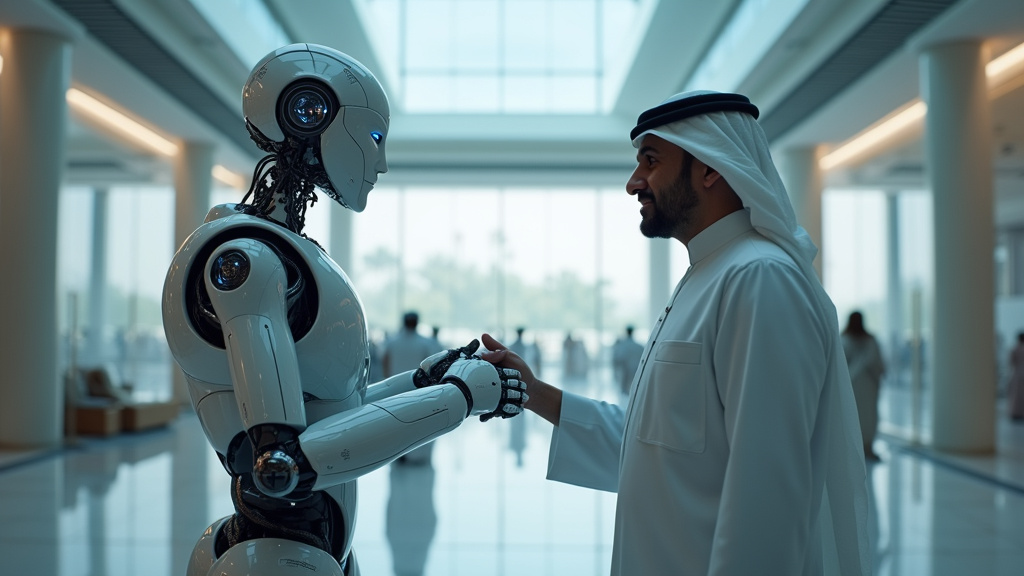The world of robotics is witnessing a pivotal moment as Unitree’s G1 humanoid robot takes center stage, garnering widespread attention and creating viral moments across continents. This innovative machine is not merely a technological marvel; it’s a testament to a new era of human-robot interaction, captivating audiences from high-profile dignitaries to everyday citizens. Unitree Robotics, a leading Chinese innovator, is driving this surge, with the G1 leading its charge into global markets, soon to be joined by the even more accessible R1.
A Global Phenomenon: The G1’s Captivating Journey
Recent weeks have placed the Unitree G1 firmly in the spotlight through a series of highly publicized appearances. In Dubai, the robot notably greeted His Highness Sheikh Mohammed Bin Rashid Al Maktoum, the Vice President and Prime Minister of the UAE and Ruler of Dubai, at Union House. This high-profile interaction underscored the region’s commitment to pioneering AI and robotics, with the G1 also integrated into the interactive exhibits of the iconic Museum of the Future.
The G1’s global tour extended to Almaty, Kazakhstan, where it donned traditional Kazakh attire to greet residents during the festive Nauryz holiday. Its personable style and willingness to engage, shaking hands and posing for photos, delighted both children and adults. Meanwhile, across the United States, a Unitree G1 affectionately dubbed “Jake the Rizzbot” became a trending social media sensation. Operated by users, Jake’s amusing interactions with passers-by in Austin, San Francisco, and Venice Beach, sporting a cowboy hat and dishing out Gen Z slang, cemented the robot’s status as a bona fide internet phenomenon.
These deployments transcend mere demonstrations, signaling a significant phase in how humans and robots can seamlessly engage and delight in diverse, real-world environments.
Engineering the Future: Inside the Unitree G1
At approximately 1.32 meters tall and weighing around 35 kilograms, the Unitree G1 is a marvel of engineering, boasting between 23 and 43 degrees of freedom, allowing for extraordinary flexibility and human-like movements. Its advanced capabilities are powered by imitation learning and reinforcement learning, with its robotic systems continuously refined through artificial intelligence. The robot features high-torque permanent magnet synchronous motors, ensuring swift response and efficient heat dissipation.
Equipped with sophisticated sensory systems, including a 3D LiDAR, an Intel RealSense D435 depth camera for panoramic scanning, and a noise-canceling microphone array, the G1 can perceive and interact with its environment with remarkable precision. Its force-controlled, highly dexterous hands enable delicate object manipulation, mirroring human sensitivity. With a top speed of 2 meters per second and a quick-release 9,000 mAh battery offering approximately two hours of operation, the G1 is designed for agility and sustained performance across various applications.
Democratizing Robotics: The Rise of the R1
Building on the G1’s success, Unitree Robotics has also introduced the R1, a move set to further accelerate the growth of the robotics ecosystem. The R1 is a more accessible and customizable humanoid robot, standing around 1.2 meters tall and weighing approximately 25 kilograms. Priced starting under $6,000, the R1 dramatically lowers the entry barrier for advanced humanoid robotics, making it attainable for research institutions, developers, and enthusiasts alike.
The R1 features 24 to 26 joints, multimodal AI capabilities for voice and image recognition, and an open platform that supports secondary development, even compatible with ROS 2. This strategic offering underlines Unitree’s vision to democratize access to cutting-edge robotics, fostering innovation across a broader user base and ensuring the news of humanoid advancement reaches every corner.
Unitree’s Vision and Market Impact
Founded in 2016 by Wang Xingxing, Hangzhou-based Unitree Robotics has swiftly evolved from a pioneer in quadruped robots to a dominant force in humanoids, with a valuation estimated at $1.7 billion. The company’s in-house development and production of core components, including motors and reducers, are key to its competitive pricing strategy.
Unitree is now undergoing mass production and delivery of its G1, solidifying its global market share and leadership position in humanoid robotics. This aggressive expansion and focus on affordability are disrupting a market traditionally dominated by higher-cost players like Boston Dynamics and Tesla’s Optimus, with Unitree positioning itself as a top contender. Industry forecasts project the humanoid robotics market to exceed $5 trillion by 2050, with Unitree’s aggressive pricing and technological advancements putting it in a strong position to capture significant market share, especially in China, where domestic manufacturers are rapidly growing.
Addressing the Future: Applications and Considerations
The implications of Unitree’s progress are vast, opening avenues for humanoid robots as assistants in diverse fields, including customer service, education, caregiving, entertainment, industrial automation, and household support. Universities are already leveraging the G1 for advanced research, exploring applications like teleoperation for clinical tasks.
As these robots become more ubiquitous, Unitree emphasizes information security and user safety, acknowledging the societal shifts that accompany such technological integration. The ongoing hype around humanoid robots is well-founded, but the company, much like the broader industry, stresses the importance of understanding current limitations, particularly regarding full autonomy in unpredictable real-world environments.
Conclusion
The Unitree G1 humanoid robot’s captivating global journey, marked by viral moments and warm welcomes, signifies a major leap forward in robotics. Alongside the strategically priced R1, Unitree Robotics is not just manufacturing machines; it is actively shaping the future of human-robot interaction by making advanced technology more accessible and engaging. As mass production accelerates and applications expand, Unitree’s vision of fun, friendly, and useful robots for humanity is rapidly becoming a reality, cementing its role at the forefront of this exciting technological revolution.





